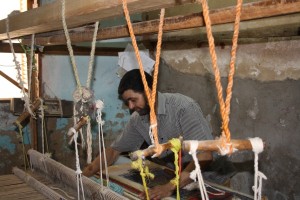
Abdel-Rahman Sherief
Carpets and rugs in Egypt come in all shapes and sizes, from dyed cotton rugs to woollen carpets with intricate patterns; they adorn many living room floors. The weaving of carpets is a traditional Egyptian craft and the weavers from the city of Fowah are among the best in the business.
In the 19th century a factory that made the then fashionable tarboush, or fez, was built in Fowah, making the city a centre of wool industry in Egypt.
The resourceful Fowah residents thought of a way to use wool surplus from the tarboush factory; at first they started to make bataniya, heavy bed covers, which led in the 1940s to the manufacturing of handmade carpets and other derivatives.
“The appearance of goblan, carpets, happened because of political reasons,” explained Sayed Amin, the executive manager of the Fowah Revival Foundation.
When President Sadat expelled the Soviet military experts who worked in Egypt in 1972, the Soviet Union punished the Egyptian authority for this decision by stopping their import of some goods manufactured in Egypt. One of the goods that were no longer ordered was the double kelem, a heavy rug made in Fowah. Faced with the loss of their principle market, the kelem makers turned to producing goblan.
Weaving became a traditional craft in Fowah and weaving workshops, or ga’a as they are known locally, can be found in every street. Each ga’a contains two or three looms and from the silence inside the workshop it is easy to tell that making a goblan takes a lot of concentration; only the crack of the wooden loom is heard.
Goblan manufacturing is a long journey that starts with collecting the wool and cleaning and processing it into threads. The threads must be washed and dried well under the sun to prepare them for the coloured dyes the weavers use. Finally, the threads are arranged according to their colour and quality and the weaver can start to transform them into a goblan. It takes up to four weeks to make an average goblan and the weavers spend eight hours a day in front of their looms, working six days a week.
There are two types of goblan; the folk ones which depict nature, and the so called ‘super’ carpets, which are high quality and expensive items that can only be made by a very skilful craftsman. The super goblan carpets often portray historic pictures either taken from Gamal Hemdan’s book Description of Egypt or from famous international portraits.
In the 1970s and 80s Fowah contained more than 20,000 goblan workshops and most of its production was exported to the European and American markets,
However, today the situation is very different. The market suffered from the emergence of artificial carpets which were popular among Egyptians because Asian producers like China and Bangladesh could offer the same quality as Fowah’s products but for lower prices.
“I have been working in this profession for more than 25 years and in the 1980s and the 90s the position of goblan craftsmen was far better than now,” said Mabrouk Shahin, a goblan weaver.
Mabrouk said that negligence of the media and the government’s fruitless marketing policies are leading to a marked deterioration of the craft. “The government must respect its responsibilities toward this craft and toward us and work on finding new channels to market our products,” he said.
Mohammed Amin, a 63-years-old weaver who has been working in this profession for 45 years, said that the media focuses on foreign products rather than promoting traditional Egyptian artistry.
The art of making goblan is in severe danger; the youngest goblan maker in Fowah is 40 years old. The youth of Fowah prefer other careers and a study done by Fowah Revival Foundation estimates that if nothing changes, the art of weaving goblan will be extinct after 25 or 30 years.
Many efforts are made by the Foundation to revive the profession’s golden age, but there is still a long road ahead to ensure the traditional craft will be saved for future generations.




